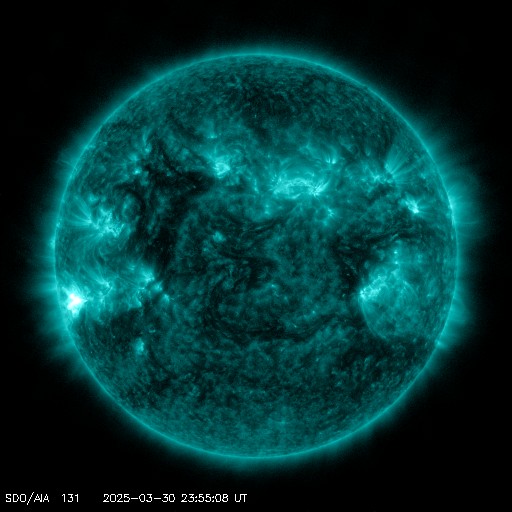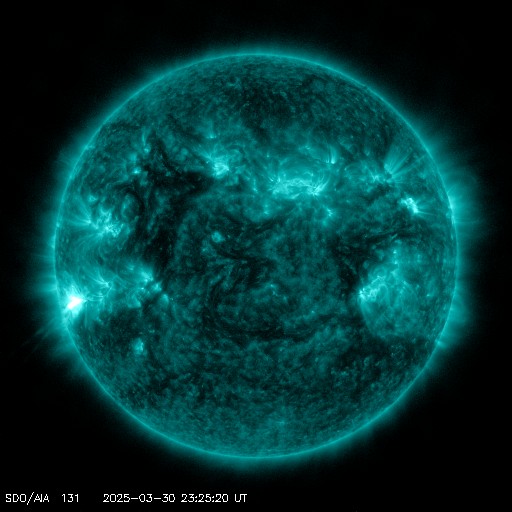Viewing archive of Monday, 21 March 2011
Solar activity report
Any mentioned solar flare in this report has a scaling factor applied by the Space Weather Prediction Center (SWPC). Because of the SWPC scaling factor, solar flares are reported as 42% smaller than for the science quality data. The scaling factor has been removed from our archived solar flare data to reflect the true physical units.
Report of Solar-Geophysical Activity 2011 Mar 21 2200 UTCPrepared by the NOAA © SWPC and processed by SpaceWeatherLive.com
Joint USAF/NOAA Report of Solar and Geophysical Activity
SDF Number 080 Issued at 2200Z on 21 Mar 2011IA. Analysis of Solar Active Regions and Activity from 20-2100Z to 21-2100Z
Solar activity increased to low levels. Isolated
C-class flares were observed, the largest of which was a
long-duration C4 at 21/1719Z from newly-numbered Region 1176
(S13E81). Region 1176 was the return of old Region 1165, which
produced M-class flares during its previous rotation. SOHO/LASCO
images showed a halo-CME, first visible in C2 images at 21/0236Z.
The halo-CME was determined to be a backside event associated with a
flare from old Region 1169 (N20, L=061).
IB. Solar Activity Forecast
Solar activity is expected to be low
during days 1 - 3 (22 - 24 March) with a chance for an M-class flare
from Region 1176.
IIA. Geophysical Activity Summary 20-2100Z to 21-2100Z
Geomagnetic field activity was at quiet levels. A greater than 10 MeV
proton event at geosynchronous orbit began at 21/1950Z and was in
progress at the time of this report. Stereo-A EUVI 195 images
indicated the source for the proton event was likely a flare from
old Region 1169 which also spawned the back sided halo-CME mentioned
above.
IIB. Geophysical Activity Forecast
Geomagnetic activity is
expected to be at quiet levels during days 1 - 2 (22 - 23 March).
Geomagnetic activity is expected to increase to quiet to unsettled
levels on day 3 (24 March) as a coronal hole high-speed stream
begins to disturb the field. The greater than 10 MeV event at
geosynchronous orbit is expected to end on day 1 (March 22).
III. Event Probabilities 22 Mar to 24 Mar
| Class M | 30% | 30% | 30% |
| Class X | 05% | 05% | 05% |
| Proton | 10% | 01% | 01% |
| PCAF | green | ||
IV. Penticton 10.7 cm Flux
Observed 21 Mar 101 Predicted 22 Mar-24 Mar 115/125/135 90 Day Mean 21 Mar 094
V. Geomagnetic A Indices
Observed Afr/Ap 20 Mar 004/004 Estimated Afr/Ap 21 Mar 002/004 Predicted Afr/Ap 22 Mar-24 Mar 005/005-005/005-008/008
VI. Geomagnetic Activity Probabilities 22 Mar to 24 Mar
| A. Middle Latitudes | |||
|---|---|---|---|
| Active | 10% | 10% | 15% |
| Minor storm | 01% | 01% | 05% |
| Major-severe storm | 01% | 01% | 01% |
| B. High Latitudes | |||
|---|---|---|---|
| Active | 15% | 15% | 20% |
| Minor storm | 01% | 01% | 10% |
| Major-severe storm | 01% | 01% | 01% |
All times in UTC
Current data suggests there is a slight possibility for aurora to appear at the following high latitude regions in the near future
Gillam, MB, Whitehorse, YT, Yellowknife, NTFairbanks, AK, Utqiagvik, AK
Latest news
Latest forum messages
Solar Demon 3Unspecified geomagnetic activity 2146AR4046 134Aurora photography hints for those of us with smartphones 54AR4048 34
More topicsSupport SpaceWeatherLive.com!
A lot of people come to SpaceWeatherLive to follow the Sun's activity or if there is aurora to be seen, but with more traffic comes higher server costs. Consider a donation if you enjoy SpaceWeatherLive so we can keep the website online!

Latest alerts
00:09 UTC - Solar flare
Moderate M1.03 flare
Sunday, 30 March 2025
23:51 UTC - Radio Blackout
Minor R1 radio blackout in progress (≥M1 - current: M1.03)
23:39 UTC - Solar flare
Moderate M1.52 flare
23:21 UTC - Radio Blackout
Minor R1 radio blackout in progress (≥M1 - current: M1.49)
23:09 UTC - Solar flare
Moderate M1.48 flare
Space weather facts
| Last X-flare | 2025/03/28 | X1.1 |
| Last M-flare | 2025/03/30 | M1.0 |
| Last geomagnetic storm | 2025/03/27 | Kp5 (G1) |
| Spotless days | |
|---|---|
| Last spotless day | 2022/06/08 |
| Monthly mean Sunspot Number | |
|---|---|
| February 2025 | 154.6 +17.6 |
| March 2025 | 127 -27.6 |
| Last 30 days | 127 -25.7 |





